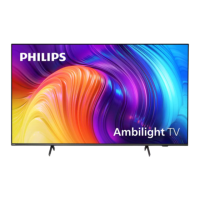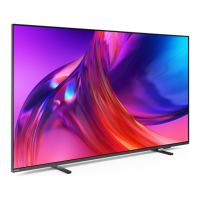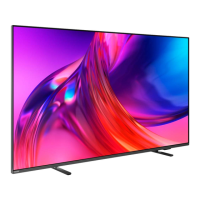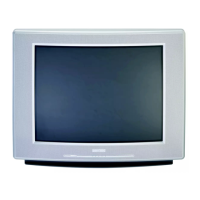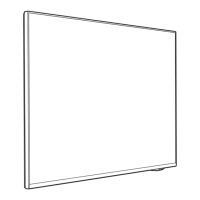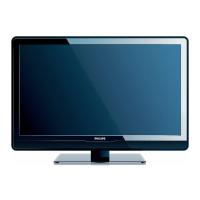
Do you have a question about the Philips 8506 Series and is the answer not in the manual?
| Display Type | LED |
|---|---|
| Operating System | Android TV |
| Ambilight | 3-sided |
| HDMI Ports | 4 |
| USB Ports | 2 |
| Refresh Rate | 60 Hz |
| Sound Technology | Dolby Atmos |
| Bluetooth | Yes |
| Wi-Fi | Yes |
| Resolution | 4K Ultra HD (3840 x 2160) |
| HDR | HDR10+, Dolby Vision |
| Processor | Quad Core |
| Voice Assistant | Google Assistant |
| Screen Size | 50", 65" |
Overview of the TV's Home screen and its channel organization.
Managing and accessing apps, including the Philips TV Collection.
Steps to open the Home screen and navigate its elements.
Essential safety instructions to follow before using the TV.
Instructions for attaching the TV stand or preparing for wall mounting.
Recommendations for optimal TV placement for viewing and Ambilight.
Guide on how to connect the TV's power cable safely.
Instructions for connecting an antenna cable to the TV.
Guide on how to connect a satellite dish to the TV.
Identification of buttons and functions on the TV remote control.
Steps to pair the TV remote control to the television.
How to use voice search with the remote control.
Information about the TV's infrared sensor for remote commands.
Instructions on how to replace the batteries in the remote control.
Guidance on how to clean the remote control properly.
How to switch the TV on or put it into standby mode.
Basic TV operations using the TV's physical keys.
Steps to install available TV channels on your television.
Information on channel lists, icons, and radio station tuning.
How to sort, filter, lock, and unlock channels.
How to tune to channels, switch channels, and view programme info.
Creating, editing, and managing favourite channel lists.
Using Teletext pages, subpages, and available options.
Exploring interactive TV features like HbbTV and iTV.
Comprehensive guide for installing satellite channels and settings.
Steps for updating and installing antenna channels.
How to copy and upload channel lists between TVs.
General guidance on connecting devices with quality cables.
Using a CI+ module and smart card for premium HD channels.
Connecting an HTS, soundbar, or AV receiver via HDMI.
Connecting smartphones and tablets wirelessly via the Philips Remote App.
Connecting a Blu-ray Disc player using HDMI and EasyLink.
Steps to pair Bluetooth devices like speakers or gamepads.
Connecting headphones and adjusting volume.
Connecting game consoles via HDMI for gaming.
Connecting and formatting a USB Hard Drive for pause/record.
Connecting a USB keyboard for text input.
Viewing photos, music, and videos from a USB flash drive.
Connecting a digital photo camera to view pictures.
Connecting a camcorder via HDMI for optimal quality.
Connecting a computer to use the TV as a monitor.
Connecting the TV to a network via Wi-Fi or wired connection.
Signing in with a Google account for full Android TV capabilities.
Using the Philips TV Collection app for premium content.
Overview of apps available on the TV and their functions.
Renting/buying movies and TV shows via Google Play.
Instructions on how to launch and close applications.
Locking apps for children or setting up restricted profiles.
Managing installed apps, storage, and cache.
Checking TV internal memory and extending storage with USB.
How to open and use the TV's internet browser.
Exploring additional options within the internet browser.
Selecting and switching between connected devices.
Setting specific options for connected TV inputs.
Renaming or changing the type of connected devices.
Rescanning connections to update the Sources menu.
Information on connecting the TV to a network.
How to pair and manage Bluetooth devices.
Adjusting picture style, color, contrast, sharpness, and brightness.
Configuring sound style, personal mode, and audio output.
Customizing Ambilight effects, styles, and lounge light.
Optimizing energy consumption through screen off and timers.
Managing USB keyboard, location, shop mode, and HDMI settings.
Setting clock, region, language, and subtitle preferences.
Managing installed apps, storage, and Android-specific configurations.
Features for users with hearing or visual impairments.
Setting parental controls, app locks, and program restrictions.
Accessing media files shared from a computer or NAS.
Adding and viewing favorite media files and folders.
Viewing and clearing lists of most popular and last played media.
Accessing photos, music, and videos from a USB drive.
Opening video folders, playing videos, and using video options.
Opening photo folders, viewing photos, and slideshows.
Opening music folders, playing music, and adding to favorites.
Requirements for using the TV Guide to view programmes.
Understanding how TV Guide data is collected and displayed.
Opening, tuning to programmes, and viewing details in the TV Guide.
Steps to record live TV, schedule recordings, and manage recordings.
How to pause and resume a TV broadcast.
Using the Philips TV Remote App as a control and media tool.
Casting apps and content from mobile devices to the TV.
Requirements and methods for playing games on the TV.
Connecting and using wireless gamepads with the TV.
Steps to start and play games from a connected game console.
Selecting Ambilight styles to follow video, audio, or lounge light.
Procedure to switch off the Ambilight feature.
General settings and help for Ambilight features.
Using Ambilight to light up the room when the TV is in standby.
Setting up Ambilight, music, and weather for a wake-up experience.
Simulating sunset to aid sleep, with automatic standby.
Connecting and configuring Ambilight+Hue and wireless speakers.
Understanding how Top Picks recommends programmes.
Accessing and using the Now on TV feature for live programmes.
Renting movies from an online video store.
Overview of Freeview Play features and benefits.
Steps to open and navigate Freeview Play programmes.
Understanding Alexa's capabilities and requirements for TV control.
Setup process for controlling the TV using the Alexa app.
How to update TV software via an internet connection.
Viewing the current TV software version and release notes.
Enabling automatic software updates for the TV.
Checking the history of successfully installed software updates.
Information regarding the open-source software used in the TV.
Details about the licenses governing the open-source software.
Receiving notifications about new software or related issues.
Details on energy efficiency, disposal, and regulations.
Information on the TV's power consumption and operating requirements.
Information on the TV's Android operating system version.
Details on tuner bands, video/audio playback, and aerial inputs.
Information on screen size, resolution, and display characteristics.
Supported video and computer resolutions and refresh rates.
Overview of TV side and bottom connectivity ports.
Details on audio output power, Dolby, DTS, and sound technologies.
Supported connections, file systems, and playback formats.
Benefits and process for registering your TV for support.
Accessing and navigating the TV's built-in help system.
Solutions for common problems like TV not switching on or remote issues.
Accessing Philips online support for help and downloads.
Contacting Consumer Care for TV support and repairs.
Crucial safety guidelines to prevent injury and damage.
Proper methods for cleaning and maintaining the TV screen.
General terms and conditions for using the television.
Terms of use, privacy policy, and settings for Smart TV features.
Terms for using the Philips TV Collection apps.
Trademarks and logos related to HDMI technology.
Trademarks and licensing information for Dolby Audio.
Trademarks and licensing for Dolby Vision and Atmos.
Information regarding DTS-HD patents and trademarks.
Information regarding DTS Play-Fi patents and trademarks.
Trademark information for Wi-Fi Alliance.
Trademark information for Kensington security products.
Acknowledgement of other trademarks belonging to their respective owners.
